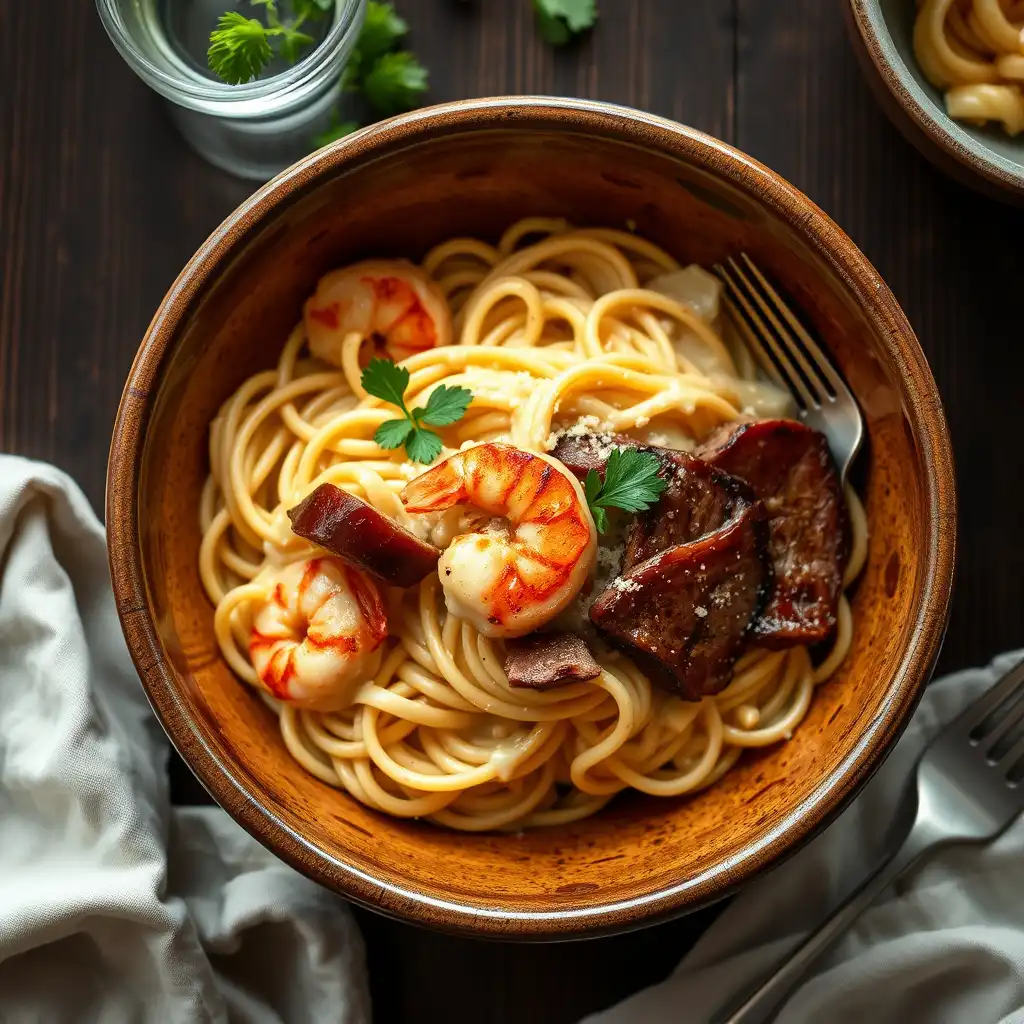Cajun Shrimp and Steak Alfredo Pasta is one of those dishes that feels like it shouldn’t work, but it absolutely does. You’ve got the richness of Alfredo, the fiery punch of Cajun spices, and the luxury of both shrimp and steak sharing the same stage. The first time I cooked it, I remember thinking—this is a flavor war, and somehow, everybody wins.
Cajun Shrimp and Steak Alfredo Pasta is special because it fuses bold Louisiana spice with Italian indulgence. You’re taking something soulful, rustic, and unapologetically spicy, then marrying it with the creamy silk of Alfredo sauce. The result is a dish that feels both comforting and daring, like pasta dressed up for a party but still wearing its work boots.
Cajun Shrimp and Steak Alfredo Pasta shines because of contrast. The shrimp—sweet, delicate, and slightly briny—goes head-to-head with the steak, which is smoky, beefy, and rich. Then there’s the Alfredo, coating everything like velvet, calming the fire from the Cajun rub but never muting it. It’s balance done loud, which is the only way Cajun should ever be.
Ingredients & Substitutions
Cajun Shrimp and Steak Alfredo Pasta needs good shrimp. Large, deveined, shell-off shrimp are best, because small shrimp disappear in the sauce, and overcooked shrimp turns rubbery fast. If shrimp isn’t available, scallops hold up beautifully, offering a similar sweetness with a meatier bite.
Cajun Shrimp and Steak Alfredo Pasta also leans heavily on steak selection. Ribeye is the king here—its marbling keeps it juicy when seared hard. Sirloin works fine, though leaner cuts risk dryness. If beef isn’t on the table, chicken thighs seasoned with Cajun spice make a worthy swap, though you’ll lose some depth.
Cajun Shrimp and Steak Alfredo Pasta’s sauce needs heavy cream. Don’t bother with half-and-half—it’ll split under heat. Parmesan must be freshly grated, not from the dreaded green shaker can. If dairy’s an issue, cashew cream with nutritional yeast creates a decent Alfredo mimic, though it’ll lean nuttier in flavor.
Cajun Shrimp and Steak Alfredo Pasta relies on Cajun seasoning, but not all blends are equal. Some are salt bombs, others go weak on the paprika. Mixing your own—paprika, cayenne, garlic powder, onion powder, thyme, oregano, black pepper—gives control. For less heat, cut back cayenne. For fire-breathing intensity, crank it up.
Cajun Shrimp and Steak Alfredo Pasta is traditionally made with fettuccine, but pasta’s a playground. Penne holds sauce in its ridges, tagliatelle creates silky ribbons, and even spaghetti will work if that’s all you’ve got. Just avoid angel hair—it overcooks too quick, and the sauce will drown it.
Step-by-Step Instructions
Cajun Shrimp and Steak Alfredo Pasta starts with the steak. Pat it dry—paper towels are your best friend here. A wet steak steams, and steaming steak is kitchen blasphemy. Cast iron is ideal for searing, though stainless steel can work if you’ve got confidence. High heat, two minutes each side, rest it like it’s been through battle.
Cajun Shrimp and Steak Alfredo Pasta next moves to shrimp. Toss them in Cajun seasoning and a drizzle of oil. A quick sear, one minute per side, just until they curl and blush pink. Don’t babysit them too long, or you’ll be chewing rubber bands instead of tender bites.
Cajun Shrimp and Steak Alfredo Pasta sauce begins in the same pan. Butter down, garlic in—let it bloom, not burn. Pour in heavy cream and reduce slightly, whisking Parmesan until it melts into silk. A pinch of Cajun seasoning ties the sauce back to the proteins, making the whole dish feel connected, not just tossed together.
Cajun Shrimp and Steak Alfredo Pasta calls for pasta that’s al dente. Boil in salted water that tastes like the sea, then finish it directly in the sauce. The pasta starch thickens the Alfredo just enough, and every strand gets dressed properly. This is not the time for timid tossing—coax the noodles until they shine.
Cajun Shrimp and Steak Alfredo Pasta finally comes together with the steak sliced against the grain, laid over the pasta like ribbons, shrimp nestled on top. A little extra Parmesan snowed over, parsley for brightness, maybe even a wedge of lemon to cut through the richness. That’s the plate you’ll want to show off.
Cooking Techniques & Science
Cajun Shrimp and Steak Alfredo Pasta works because searing locks flavor. The Maillard reaction—the browning you see on the steak—isn’t just pretty. It’s amino acids and sugars caramelizing, building savory compounds that Alfredo alone could never deliver. Without that crust, the beef would taste flat.
Cajun Shrimp and Steak Alfredo Pasta depends on timing. Shrimp and steak cook at wildly different speeds, so they must be treated separately. Throwing them in together is asking for disaster—shrimp overdone, steak underdone. Cooking them one at a time lets you hit perfect doneness for both, and that’s non-negotiable.
Cajun Shrimp and Steak Alfredo Pasta sauce thickens because fat meets starch. Cream reduces, cheese melts, and pasta starch binds them into an emulsion. Skip adding the pasta straight into the sauce, and you lose that magic—it’ll just slide around, greasy and disconnected.
Cajun Shrimp and Steak Alfredo Pasta also highlights balance in spice. Cajun seasoning has heat from cayenne but depth from herbs like thyme and oregano. It’s layered heat, not just straight burn. Alfredo cools it down without erasing it, creating that hot-cold dynamic your palate craves.
Cajun Shrimp and Steak Alfredo Pasta benefits from tools too. A cast iron skillet builds crust like nothing else, while a microplane ensures Parmesan melts evenly without clumps. Even your pasta pot matters—wide enough to let the noodles swim freely, not stick and clump like a bad dance floor.
Serving & Pairing Suggestions
Cajun Shrimp and Steak Alfredo Pasta looks best piled high, steak and shrimp showcased on top, not buried under sauce. Garnish with parsley or chives for color. A drizzle of extra-virgin olive oil or squeeze of lemon just before serving keeps it from feeling too heavy.
Cajun Shrimp and Steak Alfredo Pasta pairs well with garlic bread, though restraint is key—the pasta’s already rich. A simple side salad with a lemony vinaigrette balances it. For drinks, a crisp Sauvignon Blanc cuts the cream, while a cold lager matches the spice.
Cajun Shrimp and Steak Alfredo Pasta shines at the table when served family-style. A large platter, everyone digging in, the smell of spice and butter filling the air. This isn’t delicate food—it’s bold, loud, and meant to be shared.
Conclusion
Cajun Shrimp and Steak Alfredo Pasta is more than a recipe—it’s a performance. Bold Cajun heat, tender shrimp, juicy steak, and creamy Alfredo all layered into one dish. It’s the kind of pasta that refuses to whisper—it speaks in full volume, and everyone listens.
Cajun Shrimp and Steak Alfredo Pasta teaches technique as much as taste. The sear, the sauce, the balance of spice—each step makes you a better cook. Get one wrong, and the dish falters. Get them all right, and it’s unforgettable.
Cajun Shrimp and Steak Alfredo Pasta ultimately proves that opposites don’t just attract—they thrive. Cream and spice, land and sea, rough sear and smooth sauce. It’s a contradiction that makes sense on the tongue. And maybe that’s why this dish never fades from memory.
FAQs
How do I prevent the Alfredo sauce from splitting?
Keep the heat gentle once the cream and cheese are in. High heat makes the fat separate, turning it grainy. Always whisk, never rush.
Can I make this dish less spicy?
Yes—reduce the cayenne in the Cajun seasoning or buy a milder pre-made blend. The dish still tastes great with more emphasis on smoky paprika than heat.
What pasta works best for Cajun Shrimp and Steak Alfredo Pasta?
Fettuccine is classic, but penne and tagliatelle work beautifully. Avoid thin pasta like angel hair—it collapses under the sauce.
Can I use frozen shrimp for this recipe?
Absolutely, but thaw them fully and pat dry before cooking. Any extra water will steam the shrimp instead of searing them.
How do I reheat Cajun Shrimp and Steak Alfredo Pasta without drying it out?
Warm it gently on the stove with a splash of cream or milk. Microwave reheating tends to make shrimp rubbery, so stove is better.

Olivia P. is a seasoned food blogger at Tastywink, sharing delicious, easy-to-follow recipes inspired by him passion for home cooking. With years of culinary blogging experience, he brings flavor, creativity, and a personal touch to every dish.
